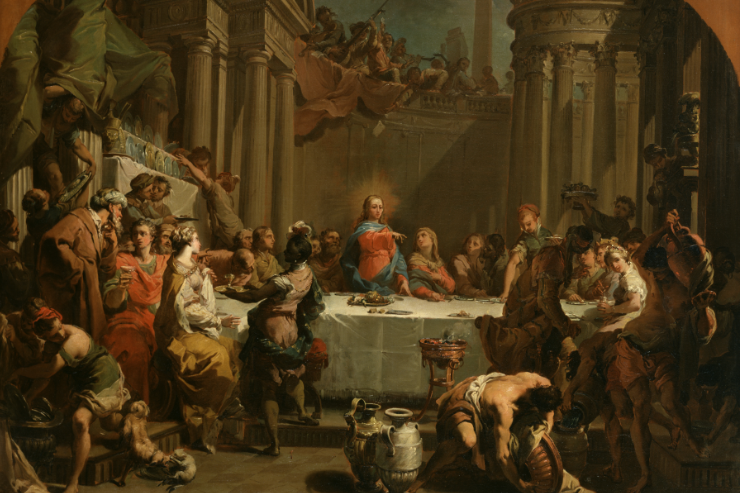A Bride and Groom; The Bride and Groom
by Bishop Robert Barron | July 18, 2017 12:04 am

“The Marriage at Cana” by Gaetano Gandolfi [Public domain], via Wikimedia Commons[1]
Two weeks ago, I had the great good pleasure of presiding at the wedding of my niece, Bryna. She has been, all her life, a lovely girl, full of joy and good cheer—and eager to give herself in service to others. Her husband, Nelson, is also a fine person, and he took the courageous step of becoming a Catholic in anticipation of his wedding. So it was a joy to join my whole family in celebrating the coming-together of this splendid couple.
But in my homily for the wedding Mass, I pointed out that we were doing so much more than exulting in the goodness and happiness of these young people. For indeed, I explained, any secular romantic could so exult. We were gathered in church, precisely because we appreciated Bryna and Nelson as more than a young couple in love, as radiant as that is. We saw them as a sacred sign, a hint, a sacrament of Christ’s love for the Church. I pointed out how it is a peculiarity of Catholic theology that a couple exchanging vows at their wedding Mass do not so much receive a sacrament as they become a sacrament. Everyone gathered in church that day believed that Bryna and Nelson coming together was not a function of dumb chance; rather, it was the consequence of God’s active providence. God wanted them to find their salvation in each other’s company, which is to imply, God wanted them, as a couple, to carry out his salvific will.
To make some of this clearer, I suggested that we read the story of the Wedding Feast at Cana with fresh eyes. Commentators often point out how charming it is that the first miraculous sign that Jesus performs in the Gospel of John is not the raising of the dead, or the healing of blind eyes, or the calming of a storm. Instead, it is providing wine so as to make more festive a humble wedding reception. This shows, they maintain, Jesus’ concern for the simplest things. This might be true as far as it goes, but such a reading overlooks the far greater truth which is actually the heart of the matter.
When the authors of the Old Testament wanted to express the faithful, life-giving, and intense love of God for the world, they rather naturally turned to the trope of marriage. The manner in which married partners give themselves to one another—completely, passionately, procreatively, in season and out—is the supreme metaphor for God’s gracious manner of being present to his people. Thus the prophet Isaiah, in a statement of breathtaking audacity, says to the people Israel, “Your builder (God) wants to marry you.” Every religion or religious philosophy will talk about obeying God, honoring God, seeking after God; but it is a unique conviction of Biblical religion that God is seeking us, even to the point of wanting to marry us, to pour out his life for us without restriction. Isaiah goes on to say that when the Messiah comes, he will preside at a great wedding banquet at which “juicy meats and pure, choice wine” will be served. Indeed, he tells us, there will be intoxicating drink in such abundance that “the very hills will run with wine.”
Now we can return to the story of the wedding banquet at Cana with deeper understanding. At a first-century Jewish wedding, it was the responsibility of the bridegroom to provide the wine. This explains why, upon tasting the water-made-wine, the steward came directly to the groom with his puzzled observation: “Usually people serve the best wine first and then later a lesser vintage, but you have saved the best wine for last.” In changing water into wine, Jesus was in fact acting as the definitive bridegroom, fulfilling the prophecy of Isaiah that Yahweh would indeed come to marry his people. Moreover, in providing 180 gallons (the superabundant, excessive amount that John’s Gospel precisely reports), he was hinting at Isaiah’s expectation that the hills themselves would run with wine. This is why St. Paul could speak of the love of husband and wife as a great “mystery,” that is to say, a sacred sign, which speaks of Christ’s love for his body, the Church. Brides and grooms in the ordinary sense symbolically evoke the Groom and the Bride.
I concluded my homily by reminding everyone present that Jesus performed a miracle long ago, transforming water into wine, but that our Mass would reach its climax in the moment when the same Lord performed an even more extraordinary sign, transubstantiating bread into his body and wine into his blood. The great wedding banquet is re-presented sacramentally at every Mass, when Christ provides, not ordinary wine, but his very blood to drink.
So Bryna and Nelson are two wonderful young people in love, and that’s reason enough to rejoice. But they are also living symbols of the Bridegroom’s ecstatic love for his Bride, the Church—and that is reason, in the very deepest sense, to give thanks.
Editor’s Note: Bishop Barron’s article first appeared June 27, 2017 on the Word on Fire[2] website and is presented here with the kind permission of the author.
Please share this article on social media.
- via Wikimedia Commons: https://commons.wikimedia.org/wiki/File%3AGaetano_Gandolfi_-_The_Marriage_at_Cana_-_Walters_371919.jpg
- Word on Fire: http://www.wordonfire.org/
Source URL: https://integratedcatholiclife.org/2017/07/bishop-barron-the-bride-and-groom/